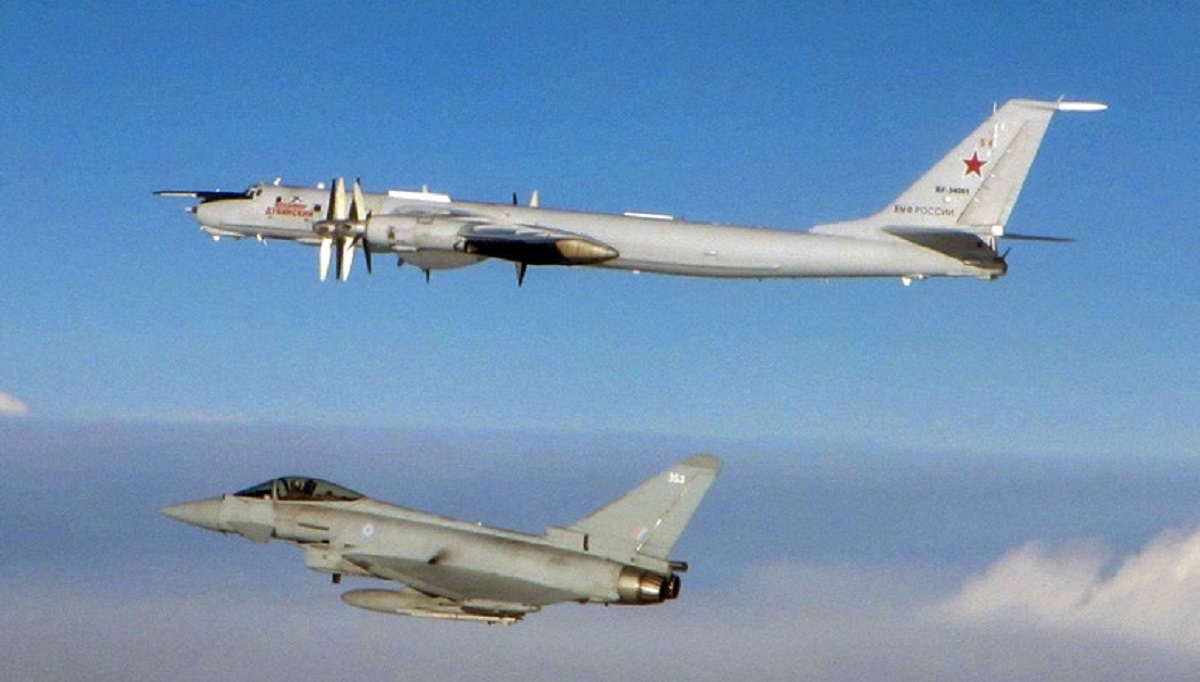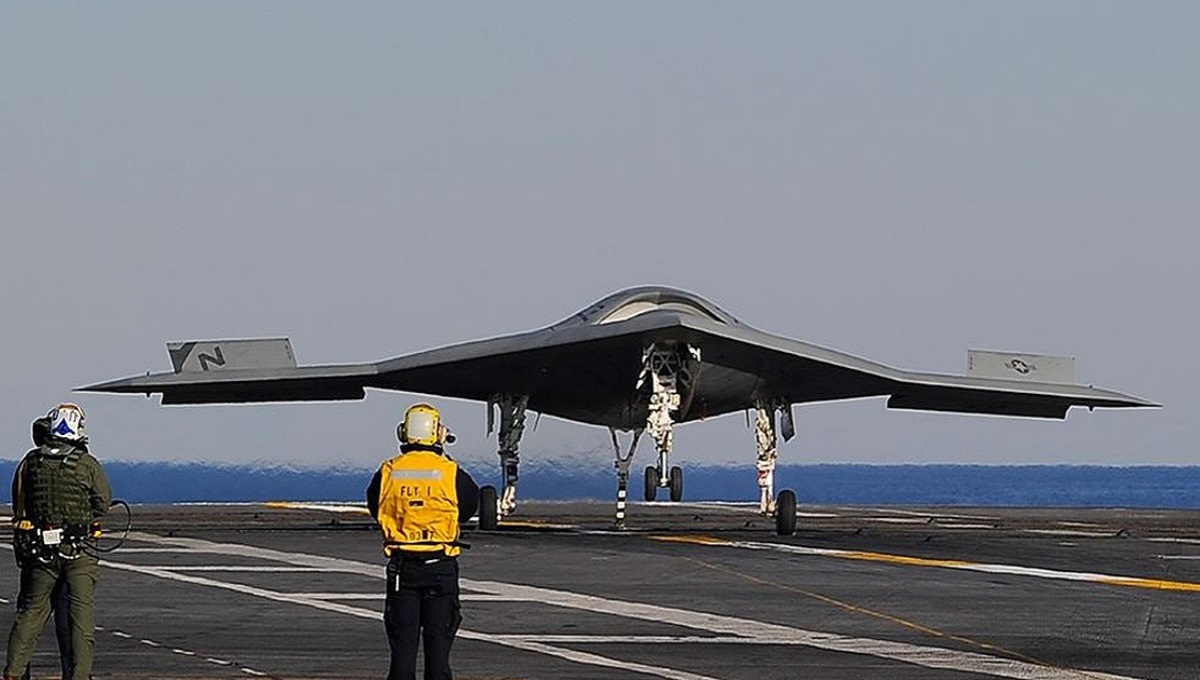The Rotor System of a helicopter refers to the rotating part of a helicopter that helps in creating the lift. This is the same part of the helicopter to which the blades are attached.
https://pagead2.googlesyndication.com/pagead/js/adsbygoogle.js?client=ca-pub-8260932016483866 (adsbygoogle = window.adsbygoogle || []).push({});A Rotor System can be horizontal like the main rotor of a helicopter which creates vertical lift and it can be vertical like the tail rotor of a helicopter which creates horizontal thrust to counter the torque.
There is also a third type of rotor system known as a tilt rotor. Tilt Rotors are those rotors that are placed at the edge of the wings. An example of a helicopter with a tilt-rotor is Augusta Westland AW609.

Rotor System Configurations
In this section, let’s have a look at different configurations of rotors. Rotor configuration means, the positioning of one or more rotors in relation to each other.
https://pagead2.googlesyndication.com/pagead/js/adsbygoogle.js?client=ca-pub-8260932016483866 (adsbygoogle = window.adsbygoogle || []).push({});In the Robinson R22 helicopter, there is a main rotor parallel to the ground and a tail rotor perpendicular to the ground. Whereas, in Boeing Chinook, there are 2 main rotors and no separate tail rotor. So, let’s discuss types of rotor configurations in helicopters in detail.
1. Single (Main) Rotor System
Single Rotor helicopters are the most common helicopters used globally. In this type of helicopter, there is one main rotor and a tail rotor to counteract the torque.
https://pagead2.googlesyndication.com/pagead/js/adsbygoogle.js?client=ca-pub-8260932016483866 (adsbygoogle = window.adsbygoogle || []).push({});The VS-300, the world’s first practical helicopter developed by Igor Sikorsky in around 1939 was also based on a single rotor and tail rotor model.
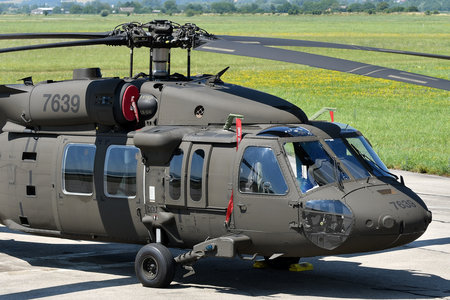
1.1 Torque Effect
When the main rotor spins, the whole body moves in the opposite direction of the wings. This is due to the torque created by the engine.
https://pagead2.googlesyndication.com/pagead/js/adsbygoogle.js?client=ca-pub-8260932016483866 (adsbygoogle = window.adsbygoogle || []).push({});To overcome the torque effect, an antitorque is required. This antitorque can be created by at least three methods i.e. a tail rotor, a fantail, and NOTAR (No Tail Rotor).
1.2 Tail Rotor
Tail Rotor is a smaller rotor in size as compared to the main rotor used to create an antitorque. It is generally present at the tail of a single-rotor helicopter. Tail Rotors are simpler to manage and this is the reason why these are used in most modern helicopters.
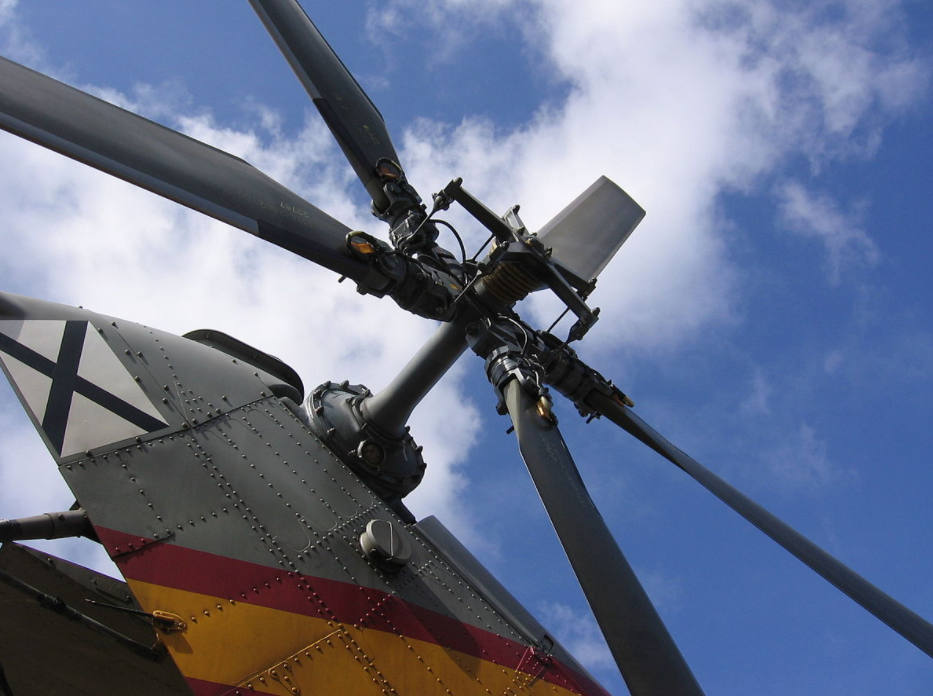
The pitch of the tail rotors can be controlled with the help of anti-torque pedals. The pitch of the tail rotor helps provide directional control.
https://pagead2.googlesyndication.com/pagead/js/adsbygoogle.js?client=ca-pub-8260932016483866 (adsbygoogle = window.adsbygoogle || []).push({});You may have seen sometimes a helicopter while hovering rotates 360 degrees on its axis. This can be done by controlling the pitch of the tail rotor.
1.3 Advantages of Single Rotor Helicopters
- Extended Hovering: Single Rotor Helicopters are best suited for applications where extended hovering is required. Longer blades can be used in single rotor helicopters which helps in creating endurance.
- Heavy Payloads: Some applications require heavy loads of men and material. Single Rotor Helicopters can be a good choice in these applications.
- Easy Operation: Only one rotor is used for creating lift in a single rotor helicopter. Along with this, there is one tail rotor and that’s it. No more complexities. This makes it quite easy to operate. This is the reason why most civil helicopters are based on a single rotor system model.
1.4 Disadvantages of Single Rotor Helicopters
- More Vibrations: Single Rotor accounts for more vibrations in the helicopter which makes the ride uncomfortable and unreliable at times. As compared to multi-rotor helicopters, single rotor helicopters have more vibrations.
- More Danger is there: The longer blades in a single rotor aircraft pose a greater danger as compared to the multi-rotor model. If there is a failure in a rotor, there is no backup. Whereas in a multi-rotor system, if one of the rotors fails, the other rotor(s) come(s) into action.
2. Tandem Rotor
Tandem Rotor helicopters have two main horizontal rotor assemblies. They are often referred to as dual-rotor helicopters.
https://pagead2.googlesyndication.com/pagead/js/adsbygoogle.js?client=ca-pub-8260932016483866 (adsbygoogle = window.adsbygoogle || []).push({});Single main rotor helicopters use a tail rotor to neutralize the torque effect of the large main rotor. However, Tandem Rotor helicopters use two large rotors and no tail rotor. So, one question automatically comes to mind that how do these helicopters work without a tail rotor?
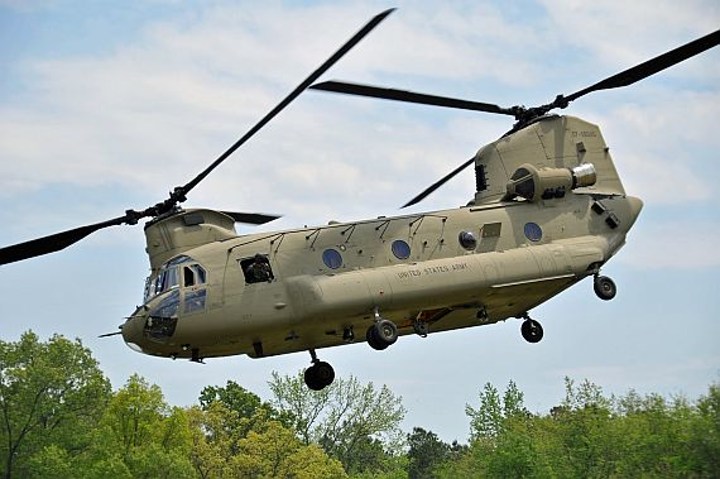
2.1 Why Tandem Rotor helicopters do not have a tail rotor ?
We know that the tail rotor in helicopters is used for counteracting the torque generated by the main rotor. In 1927, Nicolas Florine built a helicopter with a tandem rotor and invented a new mechanism to counteract the infamous torque effect.
https://pagead2.googlesyndication.com/pagead/js/adsbygoogle.js?client=ca-pub-8260932016483866 (adsbygoogle = window.adsbygoogle || []).push({});In this type of helicopter, the torque generated by one rotor is canceled out by the other rotor. At the same time, both the rotors can be used to generate the power for creating lift. Isn’t it powerful?
2.2 Why Rotors do not collide in tandem-rotor system?
The tandem rotors need to be synchronized to make sure that they do not clash with each other even if there is an engine failure. Clashing of blades in the mid-flight can be a nightmare.
https://pagead2.googlesyndication.com/pagead/js/adsbygoogle.js?client=ca-pub-8260932016483866 (adsbygoogle = window.adsbygoogle || []).push({});The GIF image below is taken from Wikipedia.
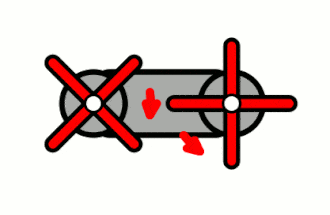
To ensure that the blades do not clash with one another, specific calculations are made like the distance between the rotors, the length of the blades, coaxial distance if present, all these calculations are done beforehand to achieve efficiency. Also in many tandem rotor helicopters like Chinook, there is an axial rotor distance between both the rotors.
https://pagead2.googlesyndication.com/pagead/js/adsbygoogle.js?client=ca-pub-8260932016483866 (adsbygoogle = window.adsbygoogle || []).push({});2.3 Advantages of Tandem Rotor
- Large Center Of Gravity: In simple terms, the center of gravity means the point at which an object balances. Have you ever tried balancing a pen on your finger? The point at which the pen balances is known as its Center of Gravity. The Center of gravity is an important parameter as it affects the stability of an aircraft.
- Longitudinal Stability: Longitudinal Stability is an important parameter in determining the stability of an aircraft under steady flight conditions. This parameter also tells us about the ease with which a pilot can handle the aircraft without much giving excess power and attention to the aircraft.
- Heavy Load Lifting Capability: Tandem-rotor helicopters have the benefit of lifting heavy loads. The two sets of rotors help in giving a stable center of gravity and provide more power to lift. This is the reason why most of the best utility helicopters used in armed forces use tandem-rotor systems.
- Makes Powerful Aircraft: As discussed earlier, in the tandem-rotor aircraft, both the rotors are used to create the lift, whereas, in single main rotor aircraft, part of the power needs to be shared with the tail rotor. This makes tandem-rotor aircraft much more powerful and among the fastest in the world.
2.4 Disadvantages of Tandem Rotor
- Complex Transmission: Two large rotors provide power in the tandem-rotor helicopters and both these rotors are connected through transmission. This transmission in tandem-rotor is very sophisticated and requires professional planning and calculations before its implementation.
- Difficult to Operate: These are not as easy to operate as single rotor helicopters. The reason is that two rotors are used to create a lift. So, along with the torque effect, the pilot also has to keep an eye on the synchronization of both rotors which needs prior knowledge and training.
3. Co-Axial Rotors
In Co-Axial Rotor helicopters, there are two rotors mounted on a mast, one above the other, and both rotors rotate on the same axis. Both of these rotate in the opposite direction to minimize the effect of torque.
This type of special rotation is also known as Contra-Rotating. The most famous helicopter with co-axial rotors is Kamov Ka-27.

3.1 History of Co-Axial Rotor Helicopters
The history of the coaxial-rotor system originates in Russia in around 1754, when Mikhail Lomonosov, a Russian Scientist displayed it in an exhibition.
https://pagead2.googlesyndication.com/pagead/js/adsbygoogle.js?client=ca-pub-8260932016483866 (adsbygoogle = window.adsbygoogle || []).push({});There is also a rotorcraft manufacturing company in Russia, JSC Kamov, which is best known for developing co-axial rotor helicopters. So, one can assume that Russia is the founder and implementor of the co-axial rotor model of helicopters.
3.2 How is Anti-Torque Generated in Co-Axial Rotor?
The anti-torque in co-axial rotor helicopters is generated by the rotors spinning in opposite directions. So, the torque generated by each rotor is canceled out by the torque of the other rotor. In this way, the net torque generated becomes zero.
https://pagead2.googlesyndication.com/pagead/js/adsbygoogle.js?client=ca-pub-8260932016483866 (adsbygoogle = window.adsbygoogle || []).push({});To achieve the yaw control, the collective pitch of one rotor is increased and the collective pitch of the other rotor is decreased. With this, a net difference in the torque is created, and controlled rotational maneuvering or yaw is achieved.
The working of two rotors in the co-axial system is almost similar to the tandem rotor system. The only difference is that, in the co-axial rotor system, both rotors have the same axis, whereas in the tandem rotor system both rotors are physically separated from each other.
https://pagead2.googlesyndication.com/pagead/js/adsbygoogle.js?client=ca-pub-8260932016483866 (adsbygoogle = window.adsbygoogle || []).push({});The GIF image below is taken from Wikipedia.
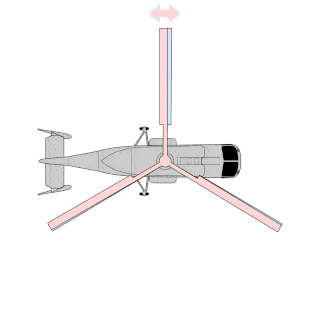
3.3 Advantages of Co-Axial Rotors
- Increased Payload With Same Engine Power: When a tail rotor is used in a helicopter, some of the engine power needs to be shared with it. So, a part of the total engine power is wasted, but in the co-axial rotor system, all of the engine power is dedicated to creating the lift, thereby increasing the total payload capacity of the helicopter.
- Reduced Noise: The noise levels in co-axial rotors are very less as compared to the single-rotor tail-rotor model. The collision of airflow from the main rotor and the tail rotor in single rotor helicopters can be noisy and severe in some designs. This airflow collision is absent in co-axial rotor systems.
- Compact Size: The co-axial rotor helicopters have a smaller footprint on the ground. However, the height of the aircraft is a bit greater, but a smaller footprint is a helpful feature of this configuration. Due to this, they are easy to land in even narrow and confined spaces. Earlier discussed Kamov helicopters are widely used for naval roles as they are capable of landing on even small ships.
- Increased Safety: The tail rotor in single-rotor helicopters is a dangerous component and can cause fatalities to the bystanders and ground staff. As there is not tail-rotor in co-axial rotor helicopters, these are safer on the ground.
3.4 Disadvantages of Co-Axial Rotors
- Mechanical Complexity: Similar to Tandem-Rotor Helicopters, the mechanical design of these helicopters is complex. Since two rotors have to be fixed on the same axis, and both rotate in opposite directions, the transmission and links from the engine become much more complex.
- Possibility of Self-Collision: According to aviation experts, this model is more prone to self-collision. When used with longer blades, the probability of self-collision of blades increases.
- Prone To Mechanical Failures: The design of the co-axial rotors requires more moving parts and components, so this model has more chances of failure. Frequent mechanical failure is one of the main drawbacks of the co-axial rotor system.
4. Intermeshing Rotors (Synchropter)
The intermeshing rotor system model is the most unusual, most uncommon, and most surprising among all the above discussed.
https://pagead2.googlesyndication.com/pagead/js/adsbygoogle.js?client=ca-pub-8260932016483866 (adsbygoogle = window.adsbygoogle || []).push({});Two rotors spinning in opposite directions are used in this model similar to tandem-rotor and co-axial rotor. But this model differs from the other two models in the fact that the rotors in this model are not parallel to the ground but are placed at some angle.
The animation below is taken from https://gfycat.com/
The movement of both rotors is synchronized in such a way that the blades intermesh with each other without colliding. This configuration of the rotors is also known as Synchropter.
4.1 Design of Intermeshing Rotor
Most of the arrangements with intermesh rotors have two blades in each mast. But some exceptions are also there like Kellet XR-10, which has 3 blades in each rotor. The complexity in design increases with the number of blades used in each mast.

The design of intermeshing rotors is not as efficient as in other models because the lift generated by each rotor is not purely vertical.
https://pagead2.googlesyndication.com/pagead/js/adsbygoogle.js?client=ca-pub-8260932016483866 (adsbygoogle = window.adsbygoogle || []).push({});4.2 History of Intermeshing Rotor Helicopters
The first intermeshing rotor helicopter was developed by Anton Flettner, a German aviation engineer. It was developed for anti-submarine warfare. In 1951, an American experimental aircraft named Kaman K-225 became the world’s first gas turbine-powered helicopter.
https://pagead2.googlesyndication.com/pagead/js/adsbygoogle.js?client=ca-pub-8260932016483866 (adsbygoogle = window.adsbygoogle || []).push({});4.3 Advantages of Intermeshing Rotor helicopters
- Stability: The Intermeshing Rotor system provides good stability during flight. Stability is an important parameter when the overall performance of an aircraft is measured.
- Good Lifting Capacity: The intermeshing helicopters are known for their powerful lifting capabilities. This is the reason why intermeshing rotor helicopters are used as cargo helicopters. These helicopters have applications in construction work etc where the heavy load needs to be lifted.
4.4 Disadvantages of Intermeshing Rotor helicopters
- Complex Mechanical Design: The design of intermeshing is quite complex and flawless synchronization is required between the blades to avoid self-collision.
- Reduced Efficiency: The overall efficiency of the intermesh rotor helicopters can be improved. Because both of the rotors are fixed at some angle rather than purely parallel to the ground due to which the maximum lift is not generated.
This limitation can never be overridden as it contradicts the basic principle of the intermeshing rotor system model.
So based upon the above parameters and performance, one can easily draw inferences and find out the most suitable helicopter according to the surroundings and other requirements. All of these outperform the other types in some parameters and all of these have some drawbacks. But the overall performance outperforms their drawbacks which makes them powerful, attractive, and luxurious machines.
https://pagead2.googlesyndication.com/pagead/js/adsbygoogle.js?client=ca-pub-8260932016483866 (adsbygoogle = window.adsbygoogle || []).push({});
